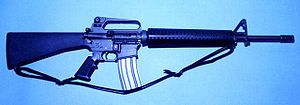Self-loading rifle: Difference between revisions
→See also: Major Miss Information |
Undid revision 226297988 by 67.61.158.10 (talk) -- vandalism. |
||
| Line 24: | Line 24: | ||
*[[List of firearms]] |
*[[List of firearms]] |
||
*[[Semi-automatic rifle]] |
*[[Semi-automatic rifle]] |
||
I believe the M16 is gas operated, and as a former drill sargent I have done much study on this weapon durring small arms training. |
|||
You even say so yourself. |
|||
http://en.wikipedia.org/wiki/M16_rifle |
|||
Please delete this entry by Miss Information. Thank you. |
|||
Wick is a tool. |
|||
==References== |
==References== |
||
Revision as of 21:56, 3 August 2008
This article is about a firearm action. For the article about the specific rifle, see L1A1 SLR (Self-Loading Rifle)

A self-loading rifle is a rifle in which the next cartridge is loaded into the chamber from the magazine as part of the action of the weapon upon firing a shot. Self-loading actions include both automatic and semi-automatic. In a semi-automatic weapon, once loaded and cocked, each depression of the trigger will fire one shot, while an automatic firearm will continue to discharge rounds as the mechanism cycles, until the magazine is emptied or the trigger is released. They may be operated by a number of mechanisms, all of which derive their power from the explosion of the powder in the cartridge that also fires the bullet. Historically, the self-loading design was the successor to the repeating rifle, which stored a number of cartridges within the weapon, but required manual action to load a fresh cartridge before each shot. Automatically loading the next round more easily allows for rapid fire.
The term "self-loading rifle" is a synonym for "semi-automatic rifle", although it can also refer specifically to the L1A1 SLR (Self-Loading Rifle) adopted by the British and Commonwealth militaries in the mid to late 1950s.
Mechanisms
Blowback
In "blowback" operation, the bolt is not actually locked at the moment of firing. To prevent violent recoil, in most firearms using this mechanism the opening of the bolt is delayed in some way. In many small arms, the round is fired while the bolt is still travelling forward, and the bolt does not open until this forward momentum is overcome. Other methods involve delaying the opening until two rollers have been forced back into recesses in the receiver in which the bolt is carried.
Gas operated

In a gas-operated mechanism, a portion of the gases propelling the bullet from the barrel are extracted and used to operate a piston. The motion of this piston in turn unlocks and operates the bolt, which performs extraction of the spent cartridge and via spring action readies the next round. Almost all modern military rifles use mechanisms of this type.
Recoil operated

In some small caliber weapons, the bolt is not restrained but is relatively heavy and held against the breech by a spring. The gas pressure in the cartridge and the weapon recoil acts to push the bolt back, but owing to inertia this action does not significantly cause loss of gas pressure until after the bullet has left the barrel. Subsequent action is similar to that of the gas operated mechanism. This type of action is simple and inexpensive to manufacture, but is limited in the power it can handle, so it is seen on small caliber weapons such as machine pistols and submachine guns.
